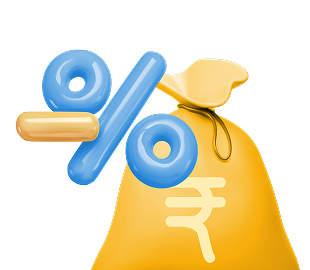Disclaimer The calculator alone is not sufficient and shouldn't be used for the development or implementation of an investment strategy. This tool is created to explain basic financial / investment related concepts to investors. The tool is created for helping the investor take an informed investment decision and is not an investment process in itself. Bajaj Finserv AMC has tied up with AdvisorKhoj for integrating the calculator to the website. Mutual Fund does not provide guaranteed returns. Also, there is no assurance about the accuracy of the calculator. Past performance may or may not be sustained in future, and the same may not provide a basis for comparison with other investments. Investors are advised to seek professional advice from financial, tax and legal advisor before investing in mutual funds.
Other Calculators
View AllEXPLORE OUR FUNDS
All Mutual Funds



















MORE ABOUT CALCULATORs
There are two main ways to invest in a mutual fund. One is through a Systematic Investment Plan (SIP) and the other is in a lumpsum. A lumpsum investment is a one-time payment into a mutual fund scheme. A sizeable sum of money is typically invested in one go and payments don’t have to be made at regular frequencies as in the case of SIPs.
Lumpsum investments can help investors potentially get the full benefits of the power of compounding when market conditions are favourable. Compounding happens if the returns on an investment, when reinvested, earn further returns. In a lumpsum investment, the entire invested capital gets the opportunity for potential compounded growth from the beginning of the tenure. In the right conditions, this can optimise return potential.
A lumpsum calculator can help you visualise the potential long-term growth of such a one-time investment.
When making a lumpsum investment, wouldn't it be wonderful to know the estimated future value of your investment? This is where a lumpsum calculator can prove to be helpful.
A lump sum mutual fund calculator is a tool that shows you the potential future value of your investment, assuming a certain tenure and rate of return.
All you need to do is enter the lumpsum investment amount, the estimated rate of return, and the time (in years) that you plan to stay invested. The calculator will instantly give you the projected future value of your investment.
Do note that estimate by the lumpsum mutual fund return calculator is based on a fixed rate of return. In reality, returns are not guaranteed, may fluctuate, and will depend on market conditions.
The calculator is an aid, not a prediction tool. It may provide only an indicative picture
The working of a lumpsum return calculator involves the following steps:
- User input: The calculator needs the user to enter the amount, expected return, and duration.
- Processing logic: The tool uses the compounding formula to project the investment’s future value.
- Output display: The calculator shows estimated returns.
The formula to calculate the potential future growth of a lumpsum investment amount follows the same concept as the compound interest formula, which is:
A = P X (1+r)n
Where:
- A = Final value of investment
- P = Initial investment amount (Principal)
- r = Annualized rate of return (in decimal, e.g., 10% = 0.10)
- n = Number of years
For example, if you invest Rs. 1,00,000 in a fund for five years and expected returns of 12% per annum.
A = 1,00,000 × (1+0.12)5
A = 1,00,000 X 1.76
A = Rs. 1.76 lakh
The Bajaj Finserv AMC is an easy-to-use tool that gives instant estimates and requires just three inputs. All you need to do is follow these steps:
Step 1: Enter the amount you have already invested or plan to invest in lumpsum in a mutual fund scheme.
Step 2: Enter the time period (in years) in which you plan to stay invested. It can range anywhere from 1 year to 30 years. A longer time period allows for more opportunities for compounding, which can potentially result in accelerated growth.
Step 3: Enter the expected rate of return. This can be based on the historical returns* of the mutual fund scheme or category you are planning to invest in. Do note, however, that the expected return rate and the actual return rate may vary.
*Past performance may or may not be sustained in future.
Once you enter these details, the lumpsum calculator will give you the potential future value of your investment. You can enter multiple numbers to see how your returns can change with the different investment amounts, tenures, or expected return rates. You can keep modifying the input values to get results that are aligned with your goals.
Using a lumpsum calculator can help you plan your investments better and choose a suitable investment amount and tenure. Instead of doing the calculations manually, you can let the calculator do the work for you and benefit in the following ways:
Here are some advantages of using a lumpsum calculator
- Quick estimates: With just a few clicks, a lump sum mutual fund calculator helps you determine in seconds what your final corpus can potentially amount to.
- Clear planning: The calculator can help you determine the investment amount and tenure that can help you potentially reach your goal amount.
- Flexibility: You can input different amounts and tenures on the tool to see the resultant final value. You can change these values as many times as you like to arrive at the amount or tenure that is aligned with your goals.
- Convenience: The mutual fund lumpsum calculator is an online tool, so you can use it whenever you need to and quickly estimate the potential future value of your mutual fund investments.
Lumpsum and SIP are two distinct approaches to investing and both have their advantages. The choice between the two depends on your finances and risk appetite.
| Investment Type | Key Points | Pros | Cons |
|---|---|---|---|
| Lumpsum | Large one-time investment | Full capital gets access to potential market growth | Higher risk at market peaks |
| SIP | Regular, smaller investments | Helps manage market volatility, encourages disciplined investing | Returns may be slightly lower than a suitably timed lumpsum |
Investors can also combine lumpsum and SIP approaches. They can use SIP to build investing discipline and spread their investment over time, but can also initiate lumpsum investments when they have surplus funds, such as after a bonus or an inheritance.
FaQs
In a lumpsum investment, the entire amount is put into the mutual fund at once. In comparison, in a Systematic Investment Plan (SIP), a fixed amount is invested in a scheme at regular frequencies, such as daily, weekly, monthly, quarterly, etc.
You can invest in mutual funds either online or offline through the following routes, among others:
1) Directly through the Asset Management Company or mutual fund house
2) Through a registered mutual fund distributor
3) Through an aggregator
4) Through a registrar and transfer agent (RTA) such as CAMS or KFintech
To make a lumpsum investment, you can follow these steps:
1) Identify a mutual fund scheme.
2) Decide on an investment amount. You can use an MF lumpsum calculator to help you plan a suitable amount based on the potential returns.
3) Apply either online or offline through the AMC, a distributor, an aggregator platform or an RTA.
The minimum amount that you can invest as a lumpsum can vary from one fund to another. There is no maximum limit.
The lumpsum investment calculator is accurate based on the values you provide. However, you should note that the returns shown in this calculator are estimates based on your inputs. The actual returns may vary depending on the fund's performance and prevailing market conditions.
Neither option is inherently better than the other. SIP encourages discipline, makes it possible to invest small amounts, and can mitigate the impact of volatility on the investment. It also does not require market timing as investments follow a schedule. Lumpsum investments have the potential for higher returns, but only when timed well. You may decide on the investment mode based on your market knowledge, risk appetite, goals, and budget. An SIP calculator and a lumpsum calculator can both help you plan your investments effectively and understand potential returns for each approach.
A lump sum mutual fund calculator cannot help you achieve your goals, but it can help you create a well-rounded plan to work towards them. Instead of manual calculations or guesswork, you can use the calculator to get clear estimates of what the future value of your investment can potentially be. It factors in your investment amount, expected return rate and investment period to estimate the potential growth. This helps you determine how much you might need to invest to potentially achieve your goal. It also allows you to experiment with different values and adjust your investment plan if needed.
The MF lumpsum calculator shows the projected return from mutual fund investment, based on the inputs you feed into the tool. It takes your expected rate of return and uses that for its estimates. However, the actual returns will depend on market movements and can vary from your expectations.
The amount can vary from scheme to scheme and can differ from one asset management company to another. It can start as low as Rs. 500, generally. However, for smaller amounts, an SIP can also be considered as it allows you to invest in affordable instalments, which, over time, can add up to a larger invested capital. Tools like SIP calculator lumpsum calculator can help you visualise the potential growth of such small investments over time.
Yes, all mutual fund investments are subject to market risk. The degree of risk depends on the type of scheme. For instance, equity funds are generally riskier than debt funds.
Mutual fund tools such as lumpsum or SIP calculators are very beneficial but also come with some limitations. The calculators give their estimates based on your inputs, which may or may not be achieved in reality. The calculators assume a fixed rate of return. However, it does not factor in market volatility and possible fluctuations in an investment’s value. Hence, tools like lumpsum, SIP calculators should only be used as a reference and for help in planning. The figures shown on them are indicative and there is no guarantee that returns will be achieved.
A lumpsum investment is a one-time investment into a mutual fund scheme of your choice as opposed to an SIP that lets you invest in a staggered manner.
Yes, online lumpsum calculators can be a suitable, user-friendly option to help you assess your lumpsum investment plan.
Lumpsum investments can be considered a suitable option when you have surplus funds through bonuses, gifts or other methods. A lumpsum investment can work for you if you have a long-term investment horizon.
Both lumpsum investments and SIP investments are fundamentally different. Hence, a comparison might not make sense. Although, what suits your investment needs can help you choose the suitable option between the two.
While a lumpsum calculator can give you a rough estimate of your financial journey, it is important to note that the results are not absolute and depend on market conditions.
Investment outcomes can vary based on multiple factors, including market movements and investment duration. Each approach has its own characteristics and may suit different situations.
Results may differ depending on timing, frequency, and market behaviour. Investors often choose an approach based on their comfort with risk and investment preferences.
The minimum amount needed for your lumpsum investment depends solely on the mutual fund you choose. Each fund has a different minimum contribution limit.
While you can make multiple lumpsum investments in a year, it is advisable to access your investment goals and check the specific mutual fund scheme page before making lumpsum investments.
Withdrawals are usually allowed as per the fund’s exit load and lock-in rules. For open-ended funds, redemption can often be done at any time, unless specified otherwise.
Yes, a lumpsum return calculator or SIP calculator lumpsum can help estimate potential returns even for short-term investments, though actual returns may vary with market conditions.
Absolutely. Using a lumpsum or SIP calculator, you can input different investment amounts, tenures, and expected returns to compare the potential outcomes of multiple mutual fund schemes.
To calculate the potential returns on a lumpsum investment, enter the investment amount, expected rate of return, and investment duration in a lumpsum return calculator or lump sum SIP calculator. The tool will instantly show the estimated future value of your investment. However, actual returns may vary and will depend on market conditions.






























